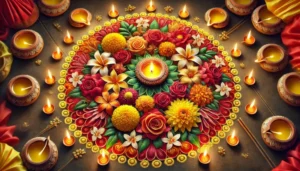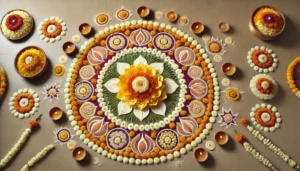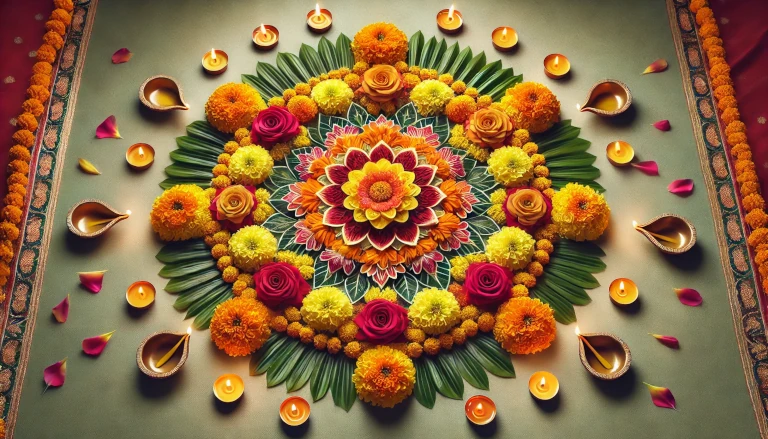Dipawali, also known as the Festival of Lights, is one of the most celebrated festivals in India. As homes and public spaces are decorated with lights, diyas, and candles, the flower rangoli holds a special place in the festival’s decor. This traditional art form is not only beautiful but also symbolic, as it is believed to bring prosperity and positivity. Using fresh, vibrant flowers such as marigold, roses, and jasmine, Dipawali flower rangolis are a perfect blend of color, creativity, and culture.
What is a Dipawali Flower Rangoli? 🌸
A Dipawali flower rangoli is a decorative design created on the floor using fresh flower petals, leaves, and other natural materials. Traditionally, these rangolis are placed at the entrance of homes to welcome guests and deities, symbolizing hospitality and good fortune. The use of eco-friendly materials like flowers not only makes the rangoli visually appealing but also connects it with nature, adding to the festive atmosphere of Dipawali.






Steps to Create a Stunning Flower Rangoli for Dipawali 🎨
- Choose Your Design:
Before starting, decide on the design you want to create. Rangoli designs can range from simple geometric patterns to more intricate shapes like lotus flowers, peacocks, or diyas. Look for inspiration online or from traditional Indian patterns. - Select Fresh Flowers 🌼:
The beauty of a flower rangoli lies in the freshness and vibrancy of the flowers you choose. Common flowers used include:
- Marigold (गेंदा) for its bright orange and yellow petals
- Roses (गुलाब) for red and pink accents
- Jasmine (चमेली) for white highlights
You can also use leaves to add contrast and depth to your design.
- Create the Base Outline:
Using chalk or white rice powder, draw the basic outline of your rangoli on the floor. This outline will help you place the flowers correctly and maintain the symmetry of the design. - Arrange the Flowers 🌹:
Begin filling in the outline with flower petals, starting from the center of the design and moving outward. For a layered effect, use different flowers for each section. Be mindful of color combinations to ensure your rangoli is visually striking. - Add Diyas or Lights 🪔:
To complete the rangoli, place small diyas (oil lamps) around the design. The soft glow of the lamps enhances the natural beauty of the flowers and adds to the festive ambiance.
Best Flowers for Dipawali Flower Rangoli 💐
🌼 Marigold (गेंदा): Known for its bold yellow and orange colors, marigolds are one of the most popular choices for flower rangolis. Their bright petals make them perfect for creating vibrant designs.
🌹 Rose (गुलाब): Available in a variety of colors, rose petals are often used to add contrast and a touch of elegance to the rangoli. Their soft texture makes them easy to work with.
🌸 Jasmine (चमेली): These small white flowers are perfect for creating intricate details and adding a fragrant touch to your design.
🍃 Leaves (पत्तियां): Don’t forget to use green leaves to provide a natural contrast between the vibrant flowers. Leaves also add a layer of texture to your rangoli.
Symbolism Behind Dipawali Flower Rangoli 🌼
Flower rangolis are not just about beauty—they hold significant meaning. In Hindu tradition, it is believed that creating rangolis at the entrance of the home welcomes Lakshmi, the goddess of wealth, ensuring prosperity and good fortune. The circular designs represent the cyclical nature of life, while the vibrant colors symbolize joy, happiness, and positive energy.






Tips for an Eco-Friendly Dipawali Flower Rangoli 🌱
With growing awareness about sustainability, many families are opting for eco-friendly decorations during festivals. Here are some tips to make your flower rangoli environmentally friendly:
- Use only fresh, organic flowers that are locally sourced to minimize your environmental impact.
- Avoid synthetic colors or artificial materials. Stick to natural elements like rice flour, turmeric, and fresh leaves.
- Compost the flowers after the celebration to avoid waste. This helps return the flowers to nature, completing the cycle of sustainability.
Why Dipawali Flower Rangoli is More Popular Than Ever 💥
In recent years, there has been a renewed interest in using flower rangolis during Dipawali. Not only are they eco-friendly, but they also offer a refreshing alternative to chemical-based colors. Additionally, creating a flower rangoli is a fun activity for the entire family, bringing people together during the festive season. With social media trends and a growing focus on sustainability, Dipawali flower rangolis are becoming a favorite for both traditionalists and modern celebrators alike.
Celebrate Dipawali with Nature’s Beauty 🌸
Creating a flower rangoli for Dipawali is a timeless tradition that continues to be cherished across generations. Whether you choose a simple design or an elaborate one, the combination of fresh flowers and artistic expression will undoubtedly add to the beauty of your celebration. By incorporating eco-friendly practices, you can make this beautiful tradition even more meaningful. So this Dipawali, light up your home with diyas and decorate your entrance with a stunning flower rangoli that embodies joy, prosperity, and the spirit of nature.
Discover more from Green Ecosystem - Renewable Energy, Agriculture, and Environmental Sustainability
Subscribe to get the latest posts sent to your email.







